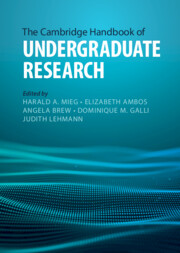Book contents
- The Cambridge Handbook of Undergraduate Research
- The Cambridge Handbook of Undergraduate Research
- Copyright page
- Contents
- Figures
- Tables
- Contributors
- Foreword
- Foreword
- 1 Introduction
- Part I Theory and Research on Undergraduate Research
- Part II Implementation, Approaches, Methods
- Part III Disciplines
- 17 Introduction
- Part III.1 STEM
- Part III.2 Health
- Part III.3 Social Sciences
- Part III.4 Humanities
- Part III.5 Arts & Design
- 36 Undergraduate Research in Design
- 37 Undergraduate Research in Architecture
- 38 Undergraduate Research in Music
- 39 Arts-Based Research for Undergraduate Students
- Part III.6 Disciplines A–Z
- Part IV International Perspective
- Part V Avenues for Developing Undergraduate Research
- Index
- References
39 - Arts-Based Research for Undergraduate Students
from Part III.5 - Arts & Design
Published online by Cambridge University Press: 11 August 2022
- The Cambridge Handbook of Undergraduate Research
- The Cambridge Handbook of Undergraduate Research
- Copyright page
- Contents
- Figures
- Tables
- Contributors
- Foreword
- Foreword
- 1 Introduction
- Part I Theory and Research on Undergraduate Research
- Part II Implementation, Approaches, Methods
- Part III Disciplines
- 17 Introduction
- Part III.1 STEM
- Part III.2 Health
- Part III.3 Social Sciences
- Part III.4 Humanities
- Part III.5 Arts & Design
- 36 Undergraduate Research in Design
- 37 Undergraduate Research in Architecture
- 38 Undergraduate Research in Music
- 39 Arts-Based Research for Undergraduate Students
- Part III.6 Disciplines A–Z
- Part IV International Perspective
- Part V Avenues for Developing Undergraduate Research
- Index
- References
Summary
Scholarship in the arts may take several forms depending on the artistic discipline. From theatrical productions, to art exhibits, to dance performances, the culmination of the work of the art form is presented in various ways. One option that crosses all art forms is arts-based research (ABR). The incorporation of ABR can be an important scholarly approach for all art forms. The implementation of ABR with undergraduate students may take several forms, including capstone courses, senior thesis projects, or undergraduate research summer scholars’ programs. The purpose of this chapter is to provide examples and strategies for making arts-based research a viable opportunity for undergraduate students in the arts disciplines. Many of the examples in the chapter are based on my work in dance in the United States, but ABR includes all art forms and all nations.
Keywords
- Type
- Chapter
- Information
- The Cambridge Handbook of Undergraduate Research , pp. 371 - 378Publisher: Cambridge University PressPrint publication year: 2022

